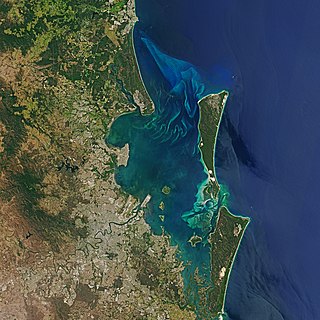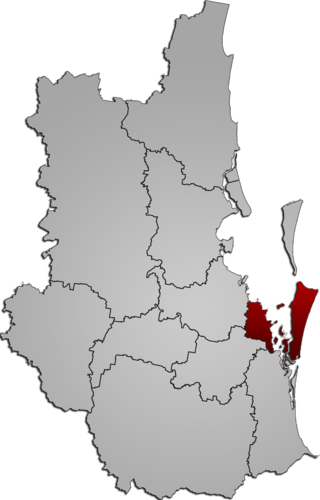Related Research Articles

Brisbane is the capital and largest city of the state of Queensland and the third-most populous city in Australia, with a population over 2.7 million. Brisbane lies at the centre of South East Queensland, an urban agglomeration with a population of approximately 4 million which includes several other regional centres and cities. The central business district is situated within a peninsula of the Brisbane River about 15 km (9 mi) from its mouth at Moreton Bay. Brisbane is located in the hilly floodplain of the Brisbane River Valley between Moreton Island and the Taylor and D'Aguilar mountain ranges. It sprawls across several local government areas, most centrally the City of Brisbane. The demonym of Brisbane is Brisbanite.

Moreton Bay is a bay located on the eastern coast of Australia 14 kilometres (8.7 mi) from central Brisbane, Queensland. It is one of Queensland's most important coastal resources. The waters of Moreton Bay are a popular destination for recreational anglers and are used by commercial operators who provide seafood to market.

Moreton Island (Mulgumpin) is an island on the eastern side of Moreton Bay on the coast of South East Queensland, Australia. The Coral Sea lies on the east coast of the island. Moreton Island lies 58 kilometres (36 mi) northeast of the Queensland capital, Brisbane. 98% of the island is contained within a national park and a popular destination for day trippers, four wheel driving, camping, recreational angling and whale watching and a 75-minute ferry ride from Brisbane. It is the third largest sand island in the world. Together with K'gari, Moreton Island forms the largest sand structure in the world. It was the traditional country of the Ngugi before settlement.

Stradbroke Island, also known as Minjerribah, was a large sand island that formed much of the eastern side of Moreton Bay near Brisbane, Queensland until the late 19th century. Today the island is split into two islands: North Stradbroke Island and South Stradbroke Island, separated by the Jumpinpin Channel.

North Stradbroke Island, colloquially Straddie or North Straddie, is an island that lies within Moreton Bay in the Australian state of Queensland, 30 kilometres (19 mi) southeast of the centre of Brisbane. Originally there was only one Stradbroke Island but in 1896 it split into North Stradbroke Island and South Stradbroke Island separated by the Jumpinpin Channel. The Quandamooka people are the traditional owners of North Stradbroke island.

Redland City, also known as the Redlands and formerly known as Redland Shire, is a local government area (LGA) and a part of Greater Brisbane in South East Queensland, Australia. With a population of 159,222 as of June 2021, Redland City is spread along the southern coast of Moreton Bay, covering 537.2 square kilometres (207.4 sq mi). The city borders the City of Brisbane to the west and north-west and Logan City to the south-west and south, while its islands are situated north of the City of Gold Coast.

Bribie Island is the smallest and most northerly of three major sand islands forming the coastline sheltering the northern part of Moreton Bay, Queensland, Australia. The others are Moreton Island and North Stradbroke Island. Bribie Island is 34 kilometres long, and 8 kilometres at its widest. Archibald Meston believed that the name of the island came from a corruption of a mainland word for it, Boorabee meaning koala. However, the correct Joondaburri name for the island is in fact Yarun.

Dunwich is a town and locality on the western side of North Stradbroke Island in Queensland, Australia. Dunwich is part of the Redland City local government area, administered from the bayside town of Cleveland on the Queensland mainland. In the 2021 census, the locality of Dunwich had a population of 737 people.

The Jagera people, also written Yagarr, Yaggera, Yuggera, and other variants, are the Australian First Nations people who speak the Yuggera language. The Yuggera language which encompasses a number of dialects was spoken by the traditional owners of the territories from Moreton Bay to the base of the Toowoomba ranges including the city of Brisbane. There is debate over whether the Turrbal people of the Brisbane area should be considered a subgroup of the Jagera or a separate people.

The Coocumbac Island Nature Reserve is a protected nature reserve located in the mid–north coast region of New South Wales, Australia. The 6-hectare (15-acre) reserve, situated on the Manning River near Taree, is a rare example of a subtropical lowland rainforest.
Turrbal is an Aboriginal Australian language of the Turrbal people of the Brisbane area of Queensland.

Woorim is a town and suburb of Bribie Island in the City of Moreton Bay, Queensland, Australia. In the 2021 census, the suburb of Woorim had a population of 1,843 people.
Jandai is an Australian Aboriginal language of the Quandamooka people who live around the Moreton Bay region of Queensland. Other names and spellings are Coobenpil; Djandai; Djendewal; Dsandai; Goenpul; Janday; Jendairwal; Jundai; Koenpel; Noogoon; Tchandi. Traditionally spoken by members of the Goenpul people, it has close affinities with Nunukul language and Gowar language. Today now only few members still speak it.

Durubalic is a small family of Australian Aboriginal languages of Queensland.

The Quandamooka people are Aboriginal Australians who live around Moreton Bay in Southeastern Queensland. They are composed of three distinct tribes, the Nunukul, the Goenpul and the Ngugi, and they live primarily on Moreton and North Stradbroke Islands, that form the eastern side of the bay. Many were pushed out of their lands when the English colonial government established a penal colony near there in 1824. Each group has its own language. A number of local food sources are utilised by the tribes.

The Yugambeh, also known as the Minyangbal, or Nganduwal, are an Aboriginal Australian people of South East Queensland and the Northern Rivers of New South Wales, their territory lies between the Logan and Tweed rivers. A term for an Aboriginal of the Yugambeh tribe is Mibunn, which is derived from the word for the wedge-tailed eagle. Historically, some anthropologists have erroneously referred to them as the Chepara, the term for a first-degree initiate. Archaeological evidence indicates Aboriginal people have occupied the area for tens of thousands of years. By the time European colonisation began, the Yugambeh had a complex network of groups, and kinship. The Yugambeh territory is subdivided among clan groups with each occupying a designated locality, each clan having certain rights and responsibilities in relation to their respective areas.
The Ngugi are an Aboriginal Australian people, one of three Quandamooka peoples, and the traditional inhabitants of Moreton Island.
The Nunukul, also spelt Noonuccal and known also as Moondjan are an Aboriginal Australian people, one of three Quandamooka peoples, who traditionally lived on Minjerribah, in Moreton Bay Area and in mainland Brisbane regions.
The Goenpul, also written Koenpal, are an Aboriginal Australian people, one of three Quandamooka peoples, who traditionally lived on the southern part of Stradbroke Island in southern Queensland. Today their preferred term for their group is Dandrubin Gorenpul.
Pimpama is an indigenous language of Australia, possibly spurious, and if real, certainly extinct. The language was spoken on the coast near modern-day Brisbane. Along with Gowar, it may have been related to the Bandjalangic languages.
References
- 1 2 E26 Gowar at the Australian Indigenous Languages Database, Australian Institute of Aboriginal and Torres Strait Islander Studies
- ↑ Jefferies, Anthony (1 September 2011). "Guwar, the language of Moreton Island, and its relationship to the Bandjalang and Yagara subgroups: a case for phylogenetic migratory expansion?". University of Queensland. Retrieved 30 September 2018.